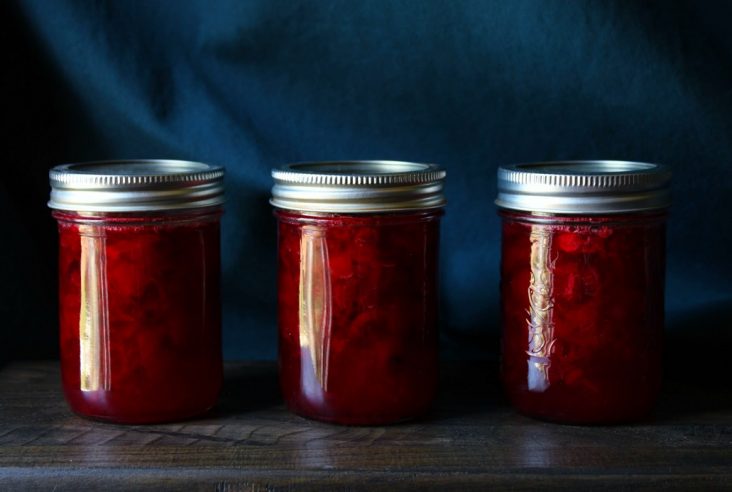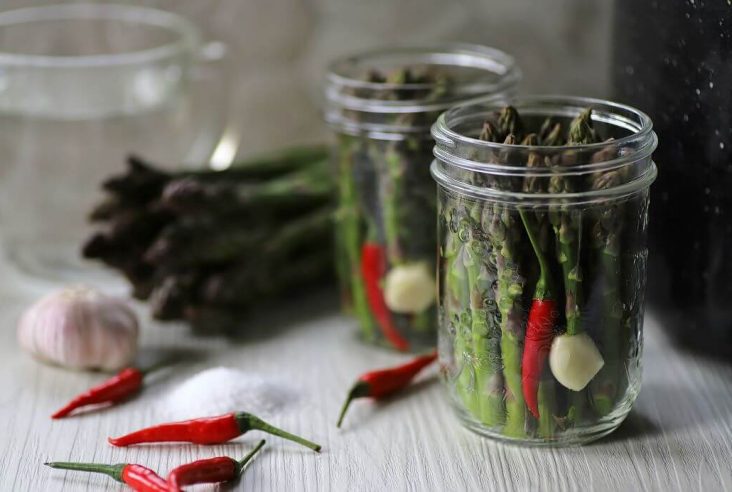Homemade Herb Salt is a vibrant and aromatic blend of fresh herbs and French Sel Gris. It is simple to make, stores for a long time, and is a great way to preserve an abundance of garden herbs. Use it on grilled and roasted meats, in salad dressings, and as a seasoning for soups, sauces, stews, and omelettes.
Summer is here and with it comes the start of preserving season. It all starts with Strawberry Rhubarb Jam in late spring/early summer right on through to pickling and canning salsa in the fall. It’s such a treat to pop open a jar of summer produce in the darkest depths of winter!

Want to save this recipe?
Enter your email below and get this post sent straight to your inbox. Plus, I’ll send you my weekly newsletter featuring the newest and best Dish ‘n’ the Kitchen recipes every week!
Homemade Herb Salt
I have my usual methods of preserving, which are annual traditions. However, it’s also fun to experiment with new methods instead of recipes… and sometimes I find a new favourite recipe in the process. I hope you give this Homemade Herb Salt recipe a try, and that you enjoy the results as much as I did.
This Homemade Herb Salt falls into the experimenting category because my go to is to dry garden herbs all summer long. Salting as preservation is a new method for me, but the results were delicious enough to do it again this year. Dried herbs are great to use in everyday recipes but this herb salt really packs a punch!
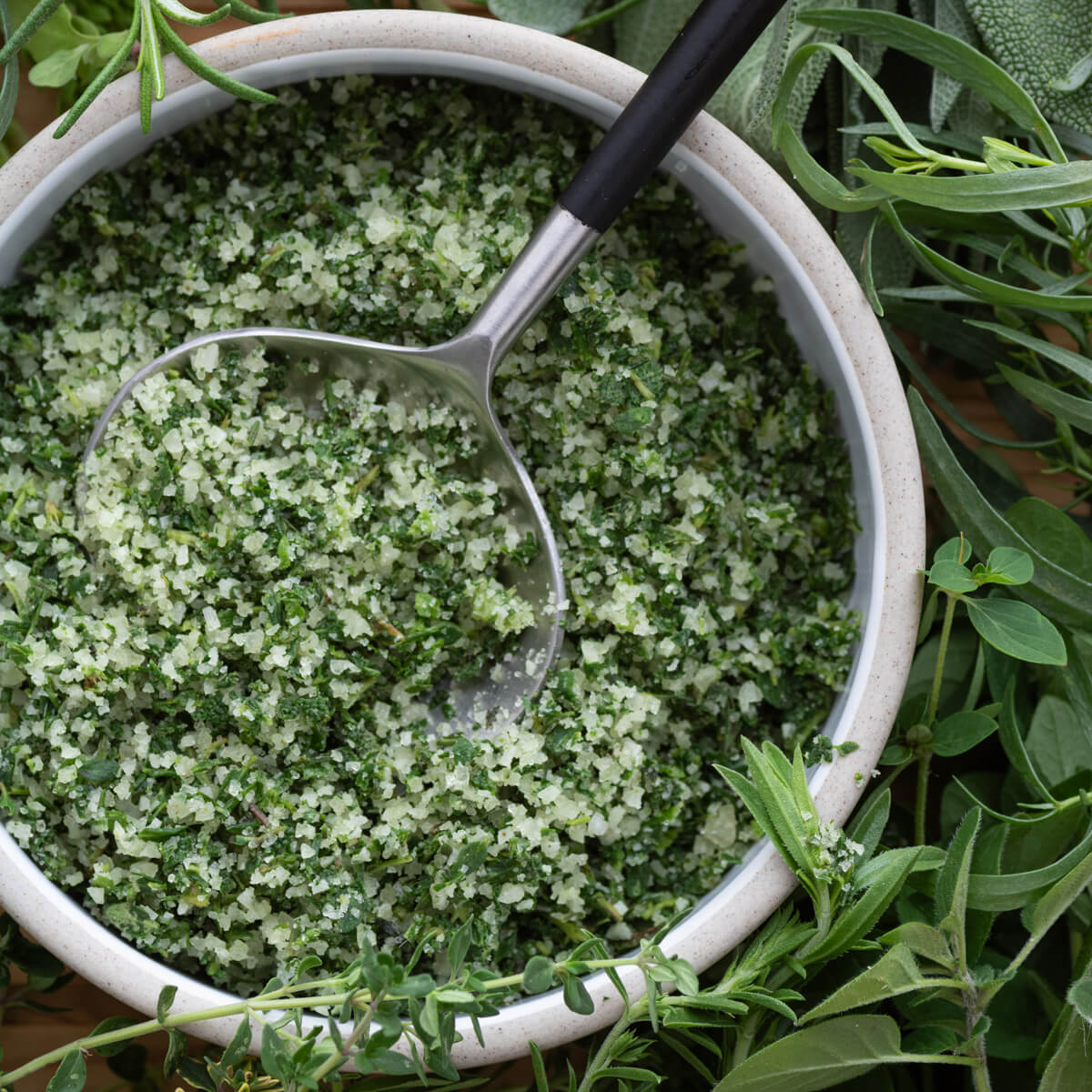
There are so many ways to use herb salt. You can use it as a dry rub for roast chicken, or as a fish flavouring. It’s also great on grilled beef, pork, or chicken and the perfect seasoning for scrambled eggs.
I also like to add it to soups, stews, and braises… and it makes a great addition to popcorn! You can also work it into some cultured butter to make compound butter. In fact, this herb salt is so delicious and so versatile, it even makes a great gift for family and friends.

My Herb Salt Preserving Method
There are several methods you can use to make this tasty salt. One method requires the herbs to be fully dry before mixing with the salt. However, this method produces a less desirable dull green colour finished product.
Another method combines fresh herbs with coarse salt in a food processor. The wet herb salt is then stored in a glass jar in the fridge which requires periodical shaking. As the jar migrates to the back of the fridge, there’s a high likelihood of forgetting to shake the jar (and resulting mold growth).
This recipe is a combination of the two methods. I used a food processor to combine the fresh herbs and coarse sea salt and employed a drying period. My aim was to briefly dry the herb salt under a very low temperature to ensure the herbs to keep their vibrant colour and flavour. It worked wonderfully!

Recipe Ingredients
As with many of my recipes, the ingredients are not set in stone. I always encourage readers to add their own touch to personalize my recipes. Feel free to use your own combination of herbs according to what is available to you and your flavour preferences.
I personally love to use different herb combinations every time. Additionally, if you have a favourite herb, you can use to make single herb salt, like rosemary salt or thyme salt. Just remember to use the same ratio of fresh herbs to sel gris (about 3:1).

- Sel Gris
- Rosemary
- Thyme
- Oregano
- Chives
- Sage
- Tarragon
- Summer Savory
- Marjoram
Note: certain herbs, like sage and tarragon can become bitter and overwhelming. Only use sage if you are going to use the herb salt for poultry. A tarragon-forward herb salt works best with fish.

What is Sel Gris?
Sel gris is a coarse grey sea salt harvested from coastal flats, or salt pans (oeillets) in France. In fact, it comes from the same oeillets as fleur de sel, the latter being the first or top harvest while sel gris comes from the base layer.
Because it precipitates just above oceanic silt or clay, it contains several beneficial minerals which give it a distinct grey or dirty colour.
Sel gris has an angular grain (as opposed to finishing salt which is flaky) and a higher moisture content than most salts. It can be used for cooking or as a finishing salt and does not dry out food like most finishing salts will (due to the high moisture content).

Finally, sel gris is denser than table or kosher salt though it can technically be used as kosher salt, since it is natural and does not contain any additives.
How to Make Homemade Herb Salt
For this recipe you will need a food processor or do it the old school way using a sharp knife and clean cutting board. Store the herb salt in a glass jar with an airtight lid.
Start by washing and thoroughly drying the fresh herbs. Next, pick rosemary, oregano, thyme, marjoram, and sage leaves (if using) from stems (discard stems). Place picked leaves in bowl of food processor along with whole tarragon (if using), summer savory, and chives.

Add sel gris to the food processor bowl. Process in small pulses until the herbs are evenly chopped. Watch carefully to prevent overprocessing into a paste.
Transfer herb salt to a baking sheet. Spread it out in a thin, even layer and place in the oven. Turn the oven light on and allow to sit in the oven until herbs are slightly dried but do not lose their vibrant colour (approximately a few hours).
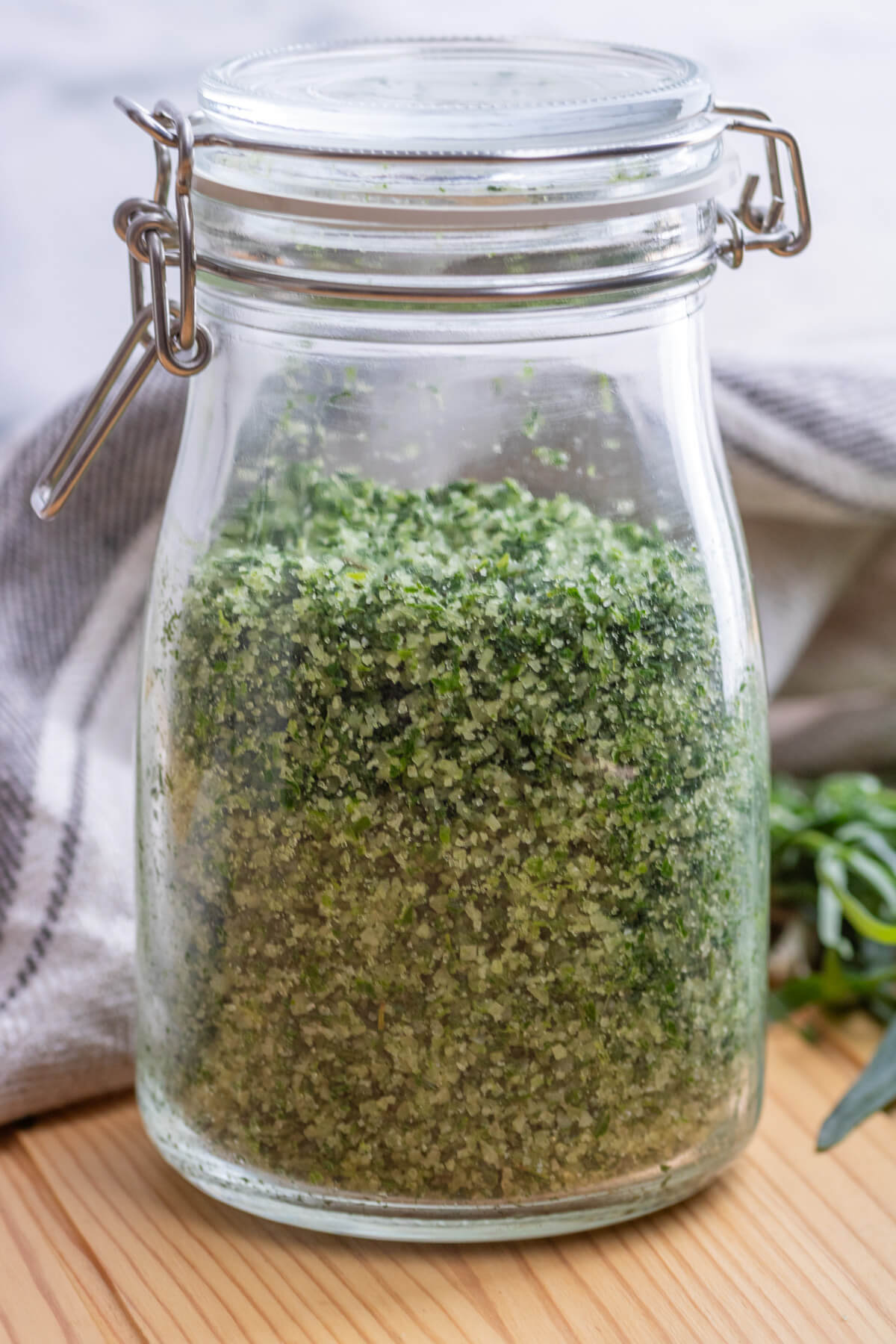
Once the mixture is partially dried, remove the baking tray from the oven and allow it to sit on the counter overnight. The next morning, place herb salt in a clean dry airtight container and store in the refrigerator.
How Long Does Herb Salt Last?
Fully dried herb salt will last over a year and be shelf stable. Since this recipe only partially dries the herbs, the finished product can last a year or more in the fridge. The vibrant colour of the herbs will fade slightly over time.

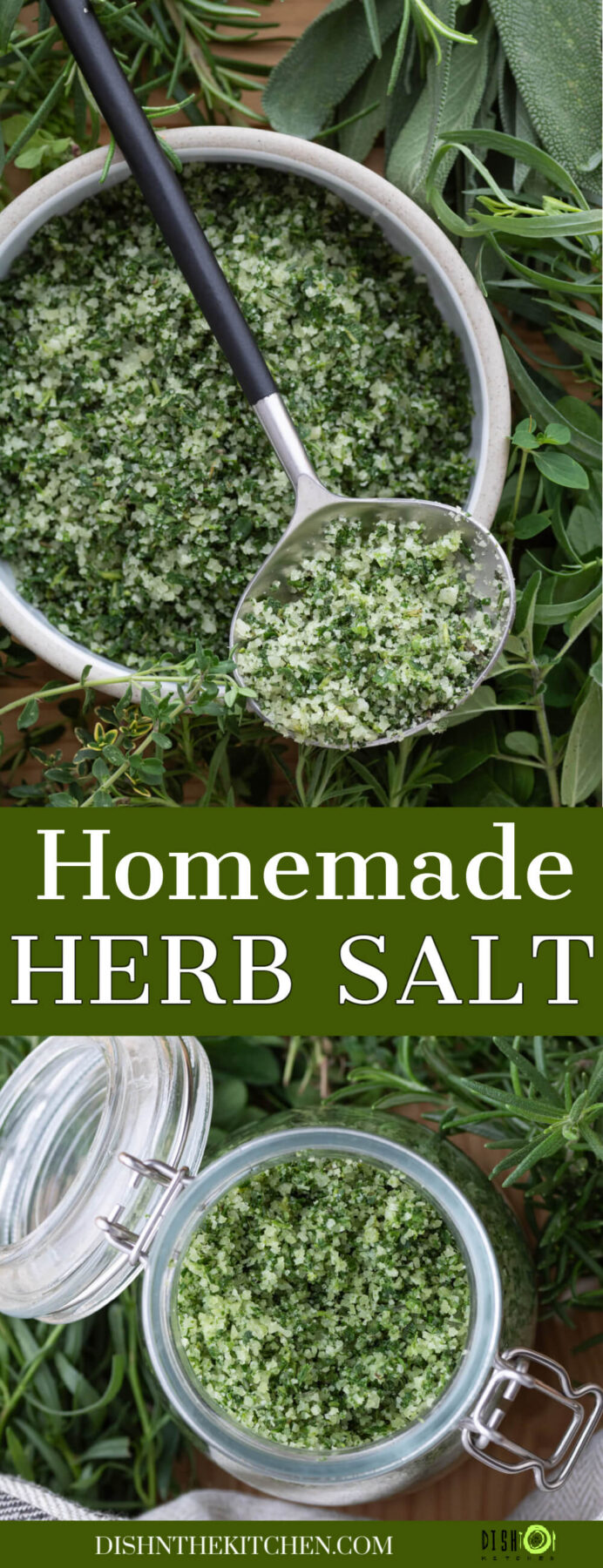
Hi! I’m Bernice Hill and I am the recipe developer, photographer, and writer at Dish ‘n’ the Kitchen. It is my pleasure to share easy to follow recipes that are delicious, nutritious, and approachable for the whole family.
If you make this Homemade Herb Salt recipe, I’d love to hear about it in the comments section or in a recipe rating. Be sure to follow me on Facebook and Pinterest for my latest recipes. Also, if you do make this recipe, please share your photos and tag me on Instagram. I hope you like this recipe!
Homemade Herb Salt
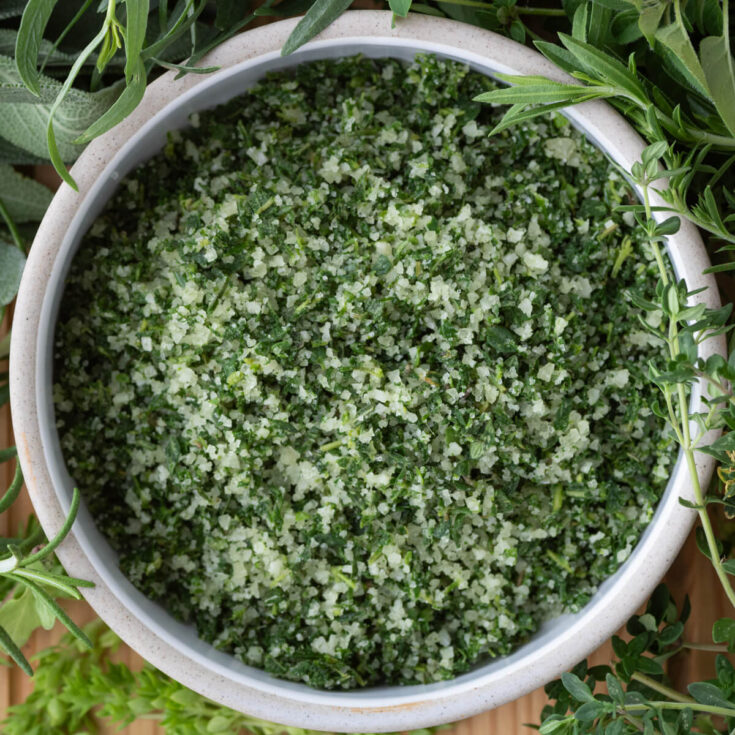
Homemade Herb Salt is a vibrant and aromatic blend of fresh herbs and French Sel Gris. It is easy to make, keeps for a long time, and is a great way to preserve an abundance of garden herbs. Use on grilled and roasted meats, in salad dressings, and as a seasoning for soups, sauces, stews, and omelettes. Drying time is approximate.
Ingredients
- 1 cup Sel Gris
- 1/2 cup fresh Oregano (loose stalks approximate amount)
- 1/2 cup fresh Rosemary (loose stalks approximate amount)
- 2 Tablespoons fresh Marjoram (loose stalks approximate amount)
- 1/2 cup Chives (loose stalks approximate amount)
- 2 Tablespoons Summer Savoury (loose stalks approximate amount)
- 1/4 cup fresh Tarragon (loose stalks approximate amount)
- 3/4 cup fresh Thyme (loose stalks approximate amount)
- 2 Tablespoons fresh Sage (loose stalks approximate amount)
Instructions
- Wash and dry fresh herbs.
- Pick rosemary, oregano, thyme, marjoram, and sage leaves from stems and discard stems. Place in bowl of food processor along with whole tarragon, summer savory, and chives.
- Add sel gris to the food processor bowl. Process in small pulses so the herbs are evenly chopped. Watch carefully to prevent overprocessing into a paste.
- Transfer herb salt to a baking sheet. Spread it out in a thin, even layer and place in the oven.
- Turn the oven light on and allow to sit in the oven until herbs are slightly dried but do not lose their vibrant colour.
- Once partially dried, remove from the oven and allow to sit on the counter overnight.
- The next morning, place herb salt in a clean dry air tight container and store in the refrigerator.
Notes
*herb amounts are estimations only.
**Feel free to play with your favourite herbs to create your own custom blend.
Nutrition Information:
Yield:
64Serving Size:
1Amount Per Serving: Calories: 1Total Fat: 0gSaturated Fat: 0gTrans Fat: 0gUnsaturated Fat: 0gCholesterol: 0mgSodium: 0mgCarbohydrates: 0gFiber: 0gSugar: 0gProtein: 0g
Nutritional calculation was provided by Nutritionix and is an estimation only. For special diets or medical issues please use your preferred calculator.



